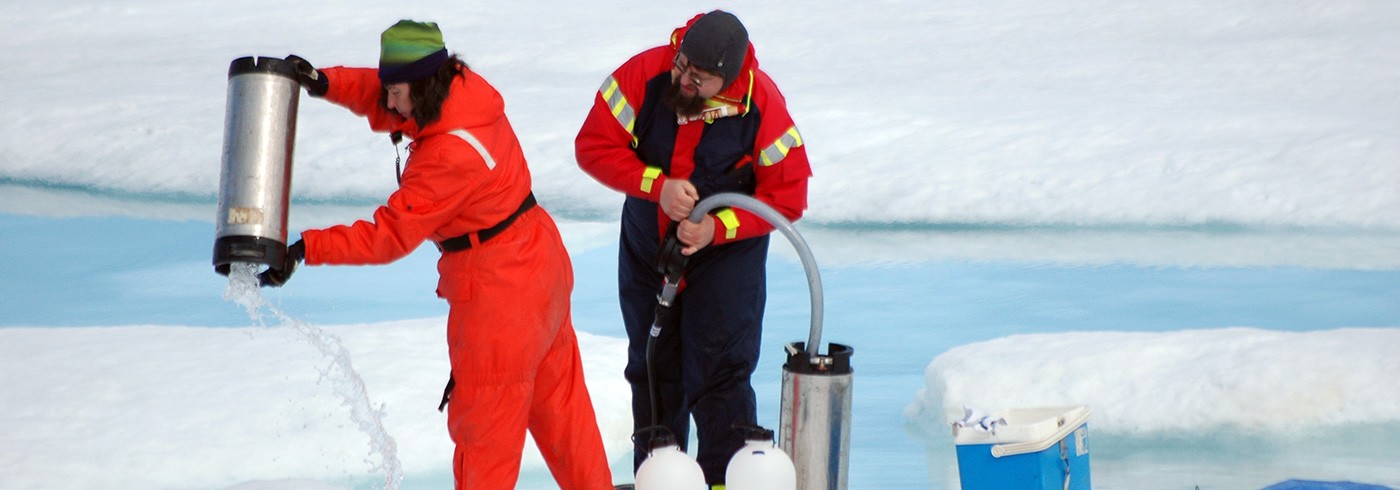A river runs through it: Dissolved organic matter in the Arctic Ocean
5 July 2005 - 25 September 2005
Distribution of in situ fluorescence across the Arctic Ocean from the Alaska coast (left) to the Svalbard shelf. Red colors indicate high fluorescence, dark colors indicate low fluorescence.
Scientific Background
Findings of the last 15 years have indicated significant environmental changes in the Arctic Ocean (Search SSC 2001) including a general warming trend, changing surface water distribution and decreasing sea ice cover. More recently major changes in the global hydrological cycle have been suggested, leading to increased precipitation and decreased surface water salinities in high latitude oceans (Curry et al., 2003), potentially contributing to increased freshwater discharge in Eurasian rivers (Peterson et al., 2002). Concern has risen as to how these changes might affect the heat budget of the Arctic Ocean, the fate of soil organic carbon stored in tundra and taiga soils, the global thermohaline circulation and the general climate in the northern hemisphere. In order to predict effects of environmental changes in the Arctic Ocean we need to develop a better understanding of how physical and biogeochemical processes in the Arctic Ocean are linked to continental run-off and atmospheric forcing. The large freshwater discharge and the extended shelf areas play an important role by influencing water mass modification on the shelf and stratification in the open Arctic Ocean. A halocline layer effectively separates the cold and fresh surface layer from the warm and salty Atlantic layer in wide areas of the Arctic Ocean. Although the role of this halocline is critical to the Arctic system we do not understand how the halocline is formed and sustained, much less how it responds to changes of freshwater discharge and sea ice formation. In a recent NSF funded investigation of the formation of the arctic halocline by using organic tracers and in situ fluorescence, we found elevated levels of terrestrial dissolved organic matter (DOM) and associated fluorescence in halocline waters. This is very intriguing and suggests the involvement of river water in halocline formation. Unfortunately we also found that the fluorescence signal can not be attributed to the terrestrial source alone, rather there seem to be several sources involved. The in situ probe is very general and does not allow any further distinction of the fluorescence signal. With the samples collected during the Beringia 2005 cruises leg 1 and 3 we hope to unravel some of these different sources by using a new method combining high resolution spectrofluorometry and parallel factor analysis. With this new method we will be in a much better position to determine the source waters involved in halocline formation, which is critical for our understanding of climate change in the Arctic Ocean system.
The fieldwork
During the two cruises on the icebreaker Oden we basically did two things. First, we monitored in situ fluorescence at every station and depth. For that purpose we either connected the probe to the seawater intake or mounted the sensor on the CTD unit to be lowered to the bottom of the ocean at every station. This gave us real time information on the horizontal and vertical distribution of fluorescence, which is caused by certain organic compounds dissolved in seawater. Second, based on the fluorescence signal we chose our sampling location and depth and collected between 1 and 20 l of seawater at several depths. We collected about 100 samples during leg 1 and 300 samples during leg 3. Each sample was split into sub-samples to determine the following parameters: dissolved organic carbon (DOC), dissolved organic nitrogen (DON), optical properties (absorbance and fluorescence), carbohydrates, lignin phenols, stable carbon, nitrogen (nitrate) and oxygen (DO) isotopes and radiocarbon for selected samples. Water samples were frozen and transported to the home laboratory for further analyses, which will take about one year to complete. Some of the analyses planned for these samples are novel to arctic oceanography and will allow significant new insight. We are especially excited about the combination of three-dimensional fluorescence and parallel factor analysis, especially in combination with new tracers such as nitrogen isotopes in nitrate.
Preliminary results
Since we already collected in situ fluorescence data we know the general distribution of fluorescence across the Arctic Ocean and we are able to find traces of fluorescence everywhere (figure). This shows that the samples we collected are extremely valuable for answering the questions of halocline formation and distribution. The figure shows the general distribution of DOM fluorescence in the upper 600 m across the entire Arctic Ocean.
Acknowledgements
We thank Professor Lars Tranvik, Department of Limnology at Uppsala University, for inviting us to participate in the Beringia 2005 expedition and for his help during planning and execution of the project and Professor Ron Benner, University of South Carolina, for letting us use his fluorescence probe. We also thank the Swedish Polar Research Secretariat for their logistical support during the entire project phase. Last but not least we thank the captain, crew and scientists on icebreaker Oden for their hospitality and professional support and Professor Ron Benner, University of South Carolina, for letting us use his fluorescence probe. Funding for this study came from the US National Science Foundation (OPP–0425582).

